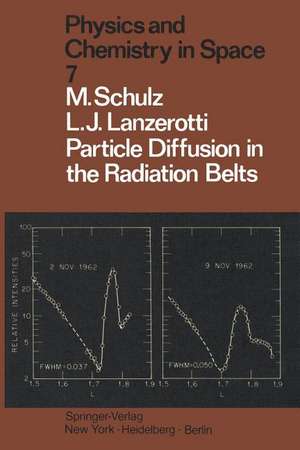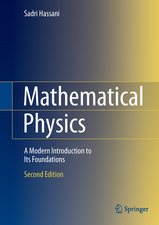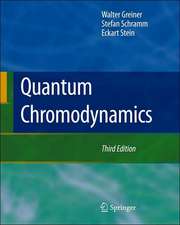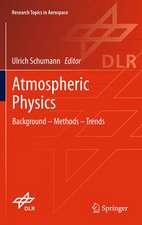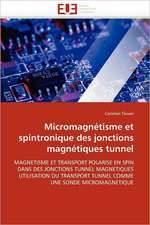Particle Diffusion in the Radiation Belts: Physics and Chemistry in Space, cartea 7
Autor M. Schulz, L. J. Lanzerottien Limba Engleză Paperback – 18 oct 2011
Din seria Physics and Chemistry in Space
-
 Preț: 385.84 lei
Preț: 385.84 lei -
 Preț: 382.18 lei
Preț: 382.18 lei - 15%
 Preț: 643.84 lei
Preț: 643.84 lei -
 Preț: 383.50 lei
Preț: 383.50 lei - 18%
 Preț: 729.84 lei
Preț: 729.84 lei - 15%
 Preț: 642.83 lei
Preț: 642.83 lei - 15%
 Preț: 637.59 lei
Preț: 637.59 lei -
 Preț: 385.08 lei
Preț: 385.08 lei -
 Preț: 381.98 lei
Preț: 381.98 lei -
 Preț: 381.43 lei
Preț: 381.43 lei - 15%
 Preț: 637.78 lei
Preț: 637.78 lei - 15%
 Preț: 634.49 lei
Preț: 634.49 lei -
 Preț: 388.34 lei
Preț: 388.34 lei -
 Preț: 392.21 lei
Preț: 392.21 lei - 15%
 Preț: 697.47 lei
Preț: 697.47 lei -
 Preț: 382.18 lei
Preț: 382.18 lei - 15%
 Preț: 643.84 lei
Preț: 643.84 lei - 15%
 Preț: 638.43 lei
Preț: 638.43 lei -
 Preț: 383.50 lei
Preț: 383.50 lei -
 Preț: 385.08 lei
Preț: 385.08 lei -
 Preț: 385.08 lei
Preț: 385.08 lei - 18%
 Preț: 777.83 lei
Preț: 777.83 lei -
 Preț: 381.81 lei
Preț: 381.81 lei
Preț: 778.32 lei
Preț vechi: 949.17 lei
-18% Nou
Puncte Express: 1167
Preț estimativ în valută:
148.92€ • 155.51$ • 122.98£
148.92€ • 155.51$ • 122.98£
Carte tipărită la comandă
Livrare economică 16-30 aprilie
Preluare comenzi: 021 569.72.76
Specificații
ISBN-13: 9783642656774
ISBN-10: 3642656773
Pagini: 236
Ilustrații: X, 218 p.
Dimensiuni: 155 x 235 x 12 mm
Greutate: 0.34 kg
Ediția:Softcover reprint of the original 1st ed. 1974
Editura: Springer Berlin, Heidelberg
Colecția Springer
Seria Physics and Chemistry in Space
Locul publicării:Berlin, Heidelberg, Germany
ISBN-10: 3642656773
Pagini: 236
Ilustrații: X, 218 p.
Dimensiuni: 155 x 235 x 12 mm
Greutate: 0.34 kg
Ediția:Softcover reprint of the original 1st ed. 1974
Editura: Springer Berlin, Heidelberg
Colecția Springer
Seria Physics and Chemistry in Space
Locul publicării:Berlin, Heidelberg, Germany
Public țintă
ResearchCuprins
I. Adiabatic Invariants and Magnetospheric Models.- I.1 Preliminary Considerations.- I.2 Action-Angle Variables.- I.3 Liouville’s Theorem.- I.4 The Dipole Field.- I.5 The Distorted Field.- I.6 Magnetospheric Electric Fields.- I.7 Flux Mapping and Shell Tracing.- II. Pitch-Angle Diffusion.- II.1 Violation of an Adiabatic Invariant.- II.2 Collisions.- II.3 Wave-Particle Interactions.- II.4 Bounce Resonance.- II.5 Cyclotron Resonance.- II.6 Limit on Trapped Flux.- II.7 Weak Diffusion and Strong Diffusion.- III. Radial Diffusion.- III.1 Violation of the Third Invariant.- III.2 Magnetic Impulses.- III.3 Electrostatic Impulses.- III.4 Bounce Resonance.- III.5 Cyclotron Resonance.- III.6 Bohm Diffusion.- III.7 Shell Splitting.- III.8 Diffusion in More Than One Mode.- IV. Prototype Observations.- IV.1 Preliminary Considerations.- IV.2 Decay of Particle Flux (Inner Zone).- IV.3 Decay of Particle Flux (Outer Zone).- IV.4 Statistical Observations.- IV.5 Static Flux Profiles.- IV.6 Time-Varying Flux Profiles.- I V.7 Fluctuating Magnetospheric Fields.- IV.8 Drift Echoes.- V. Methods of Empirical Analysis.- V.1 Basic Objectives.- V.2 Pitch-Angle Eigenmodes.- V.3 Quadrature (Spatial).- V.4 Quadrature (Temporal).- V.5 Variational Method.- V.6 Temporal Integration.- V.7 Spatial Integration.- VI. Summary.- References.- Frequently used Symbols.
